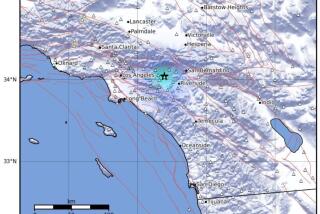N. California Wakes Up to a 5.3 Temblor
SAN FRANCISCO — A strong, rolling earthquake and several small aftershocks shook Northern Californians awake early this morning. Injuries and damage were generally minor, although the quake did put out of operation a telescope at the James Lick Observatory.
Although it peaked at 5.3 on the Richter scale and was felt as far north as Santa Rosa and as far south as San Luis Obispo, the 3:55 a.m. temblor caused no serious personal injury. Hospitals reported only a few people seeking care for scrapes and bruises, including some who cut their feet walking on broken glassware.
The quake, which hit less than a month before the 80th anniversary of the devastating San Francisco earthquake and fire of 1906, struck hardest at the James Lick Observatory on Mount Hamilton, about 50 miles southeast of here and just south of the earthquake epicenter.
Old Cracks Widened
Ron Laub, superintendent of the University of California, Santa Cruz facility, said the earthquake widened several existing cracks in one building that houses the observatory’s original 36-inch refractor telescope, and the building was closed.
At the same time, he added, the shaking cracked a number of fittings in the hydraulic system that positions the newer, 120-inch telescope. That piece of equipment was left inoperable, he said, and engineers were called in for repairs.
Elsewhere the damage was less severe. Wineries near the observatory said they suffered no damage at all. A liquor store in Fremont, the city nearest the epicenter, reported many broken bottles, but other stores and supermarkets said their wares stayed put.
Nuclear Plants OK
Commercial nuclear power plants in Sacramento and San Luis Obispo weathered the temblor without incident, said a spokeswoman for the Nuclear Regulatory Commission office in Walnut Creek.
Pacific Gas and Electric Co. said swaying electrical lines and some rattling equipment blacked out about 9,300 customers in San Jose and Fremont, but power was restored to most homes by 7:30. A spokesman for the Bay Area Rapid Transit District said his agency’s subway trains were unaffected and were operating normally.
The earthquake was a puzzle to scientists at the University of California, Berkeley. Prof. Bruce Bolt, director of the seismographic station there, said the temblor occurred somewhere in the San Andreas system, though not on that well-known fault and not in the fashion common to earthquakes in the region.
“One of the interesting things about it is that it doesn’t seem to be located on any known fault in the Mount Hamilton area,” he said. “When I rushed in here this morning, I would have sworn it was on the Calaveras fault, but it wasn’t. In fact, it wasn’t anything at all like we would have expected from that fault.”
Particularly odd, he said, was that the earth apparently slipped vertically during the quake, not horizontally, as is normal in the San Andreas system.
More to Read
Sign up for Essential California
The most important California stories and recommendations in your inbox every morning.
You may occasionally receive promotional content from the Los Angeles Times.









